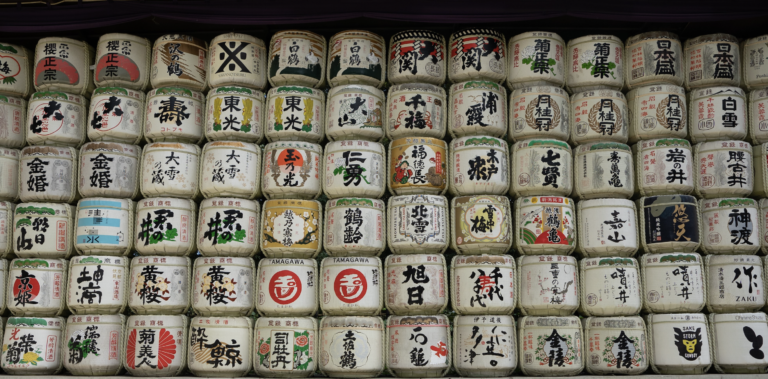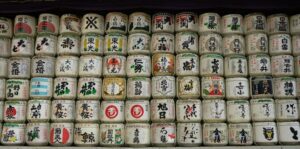
October 1st: Sake Day in Japan
On October 1st, Japan celebrates Sake Day. Japanese sake has evolved into a category enjoyed worldwide.
October 1 is Sake Day, a busy time of year for sake breweries as they begin to make sake from the newly harvested rice. In the sake industry, there is a period called the brewing year. The annual production volume is generally measured in terms of the brewing year (BY), which reflects the production period, rather than the CY or FY. Currently, the period is from July 1 to June 30, but it used to be from October 1, the current Sake Day, to the end of September of the following year.

In 1978, the Japan Sake and Shochu Makers Association (JSS) designated October 1 as Sake Day to renew the desire to pass on Japan’s national drink, sake, to future generations and to further deepen the love and understanding of sake. The Japanese word “Kampai,” which has recently become well-known overseas, is a wish for people to unite their hearts in the presence of God.
Status of sake in Japan and abroad
Demand for sake has taken on a completely different aspect in Japan and abroad. According to a survey by the National Tax Agency, domestic shipments of sake peaked in 1973, with approximately 190 million 9L cases. However, it has continued to decline since then, reaching 44 million cases (9L equivalent) in 2022, about one-fourth of its peak. However, the major drop in volume was in entry level’s sake, known as Futsu-shu, while the percentage of premium sake, known as Tokuteimeisho-shu, has been relatively increasing, reaching 36% of the total in 2022.
Although domestic shipments of sake overall from January to July 2023 are on a recovery track, approximately +20% year-on-year, due in part to a rebound from the large drop in Covid-19 in 2022, domestic demand is still not as strong as in other categories.
On the other hand, exports reached a record high for the 13th consecutive year, exporting approximately 4 million 9L cases or 47.5 billion yen to 72 countries and regions in FY2022. In terms of volume, this represents 8% of total sake shipments combining both domestic and exports. In addition, the CAGR of export value over the past 10 years from 2013 to 2022 was +18%, with export value expanding 4.5 times over this 10-year period. In addition, the unit export price per 720 ml bottle in 2022 was 953 yen, more than double the 2013 price, indicating that high-quality sake has been actively exported. In addition, in terms of export value by region in 2022, Asia and North America account for 90% of the total, with Asia accounting for 65% and North America 25%, respectively, while Europe accounts for 6%.
Sake is often consumed at Japanese restaurants abroad. The increase in the number of Japanese restaurants, especially since Japanese cuisine was registered as a UNESCO World Heritage in 2013, has led to a rapid rise, with the count reaching 159,000 restaurants by 2021, nearly tripling since 2013. This growth in Japanese restaurants and the expansion of sake exports are closely correlated.
Commenting on the change in perception of sake in the U.S. over the past five years, U.S. Master Sommelier Evan Goldstein said, “There has been a tremendous change in the perception of sake in the U.S. In the past, sake was served exclusively in Japanese restaurants and often served hot. However, in recent years, there has been an increase in establishments outside of Japanese restaurants that offer Japanese sake, with some offering a wide variety (often more than 12 types) of sake. Furthermore, there has been a rise in restaurants that not only pair sake with Japanese cuisine but also incorporate it into Western-style meals. While, there is still a need for further education, but I think sake will become a mainstream alcoholic beverage in the future.”
About Rice Production Areas
Sake is still often misunderstood as a spirit but is a brewed beverage made from rice and water. Just as grapes are crucial for wine, the quality of rice is of utmost importance for sake.
The types of rice used in sake can be broadly categorized into two main groups: sake rice, known as “sakamai,” which is specifically developed for sake production, and table rice, which is intended for consumption as a food staple. Yamada-Nishiki is the most widely produced sake rice a similar position to Cabernet Sauvignon in grape variety. According to a survey by the Ministry of Agriculture, Forestry and Fisheries, in 2022, Yamadanishiki accounted for 35% of sake rice production . It was followed by Gohyakumangoku at 19%, Miyamanishiki at 5%, and then Omachi, known for its popularity among enthusiasts, at 3%.
In 2022, Hyogo Prefecture had the highest production ratio of sake rice at 28%, followed by Niigata Prefecture at 13% and Okayama Prefecture at 6%. Sake rice production regions naturally have a significant presence of sake breweries and contribute to the overall sake production. Unlike grapes, rice can be transported, allowing high-quality rice to be distributed to various regions, resulting in the production of high-quality Japanese sake throughout Japan.
Sustainable Activities in the Sake Industry
The sake industry is actively engaged in sustainable initiatives, with the goal of contributing to a sustainable society and harmonious coexistence with local communities. These efforts encompass various aspects of rice cultivation, sake production, and distribution:
1.Precision Agriculture: To reduce the environmental impact of rice cultivation, the industry is increasingly utilizing drones to monitor rice growth from above. This technology enables more precise fertilizer application, reducing excess usage while maintaining high-quality rice production.
2.Robotic Farming: Some rice farmers have adopted robotics to manage weed control in rice paddies. This approach promotes organic rice farming by reducing or eliminating the need for chemical herbicides.
3.Waste Utilization: Sustainability efforts extend to minimizing waste. Rice bran, a byproduct of the rice-polishing process, is often repurposed as organic fertilizer, reducing waste and promoting sustainable agriculture. Additionally, sake lees, the residual solids left after pressing the mash, can be upcycled and sold as sweets, further reducing waste and generating additional income.
4.Carbon Neutrality: Some sake breweries have achieved carbon neutrality in both Scope 1 (direct emissions) and Scope 2 (indirect emissions from energy sources) emissions. This demonstrates the industry’s commitment to reducing its carbon footprint. In Scope 3, we expect to see more efficient logistics, lighter weight bottles, and the elimination of unnecessary gift boxes.
The Potential of Sake
Hitoshi Utsunomiya, director of the JSS, explains the potential of sake: “Sake is rich in rice-derived amino acids and has a mild acidity, making it a new alcoholic beverage that can be enjoyed with meals, and its use is expanding beyond Japanese cuisine.”
“Sake is a sophisticated and complex beverage. A traditional sake, known for its subtlety and rich flavor profiles, pairs exceptionally well with charcuterie, a French delicacy that exhibits distinct flavors in each region,” says Valeria Tenison, a sommelier and journalist residing in France. In France, an increasing number of Michelin-starred restaurants are including sake in their wine pairings, and more pairings with local food are expected in the future.
In the U.S., sake is increasingly being served by the glass and used in cocktails in restaurants. In Hong Kong, many retailers carry sake as well as wine, and some sell sake that is rarely available in Japan.
In Chile, a sake category was created in 2021 in the Catad’Or, one of the most prominent competitions in South America, and some hotel bars are now selling sake.
Sake breweries in the United States, France, China, Australia, Spain, the United Kingdom, and elsewhere in the world are now producing sake, creating an environment where entry-level to high-end sake is widely served at high-quality levels around the world. We hope that October 1, Sake Day, will provide more opportunities to enjoy sake.

About Sake Day Events
The JSS will hold an online event on Youtube live from 6pm on October 1 (JST). You can experience the moment when the world is connected by sake, including a video that connects the world with a toast.

In addition, a campaign will be conducted at liquor stores and supermarkets in Japan, where 1,001 consumers who purchase sake for 2,000 yen or more will be selected in a drawing to receive carefully selected local sake from throughout Japan to stimulate demand for domestic sake consumption.
The Japan Sake Information Center, operated by the JSS, will also host the “Sake Festival 2023, where visitors can enjoy new sake experiences, including chocolate sake pairing seminars, sake cocktail classes, and warmed-sake classes.”
Currently, “koji making,” a key technique in sake brewing, has been submitted for registration as a UNESCO World Heritage Site. Following Japanese cuisine, the registration of koji production for sake is expected to further increase the recognition of this special beverage. Although there is still a misconception around the world that sake is to be confused with spirits or that it is to be drunk extremely hot , many people are captivated by sake once they have had a taste of it. The JSS will continue its efforts to increase the number of sake lovers by providing the world with correct knowledge of sake and its appeal.
